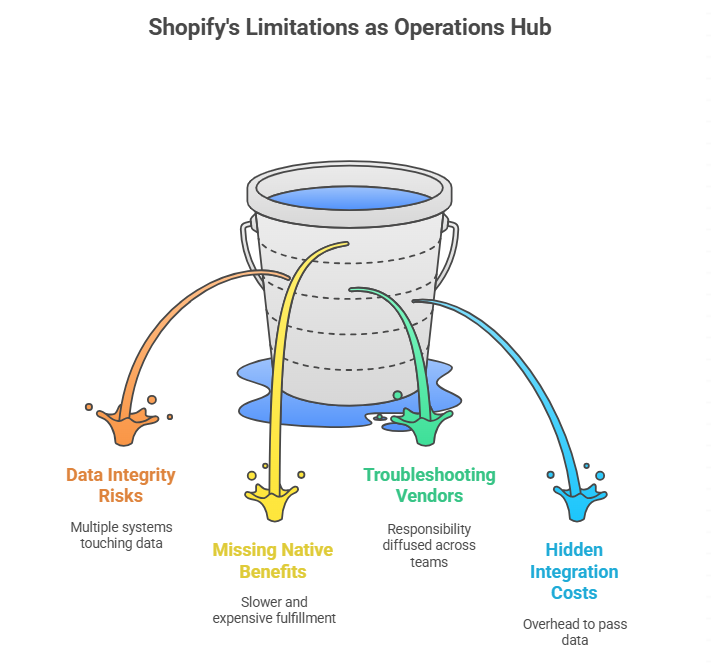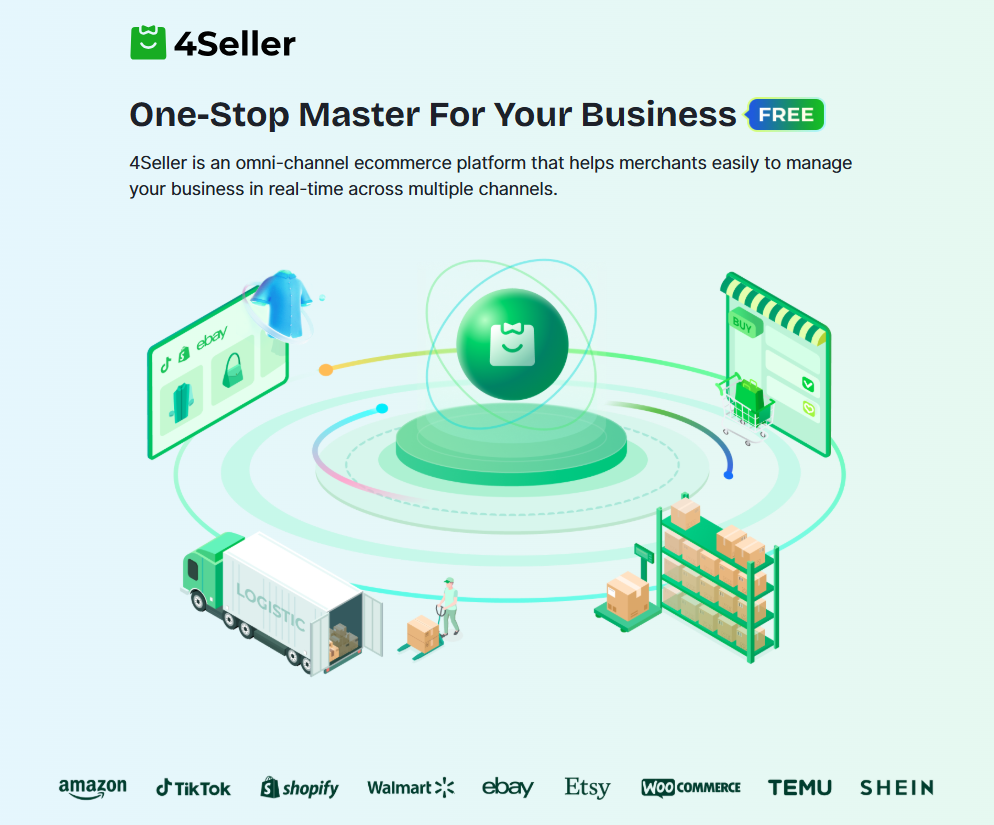- Order Management
- TikTok Shop
- Temu
- About 4Seller
- Amazon
- Shopify
- Inventory Management
- Amazon MCF&FBA
- Amazon Shipping
- UPS
- FedEx
- DHL Express
- Listing Management
- Creator Bulk Invite
- GLS
- Seller Tips
- eBay
- Shein
- Marketplace News
- Royal Mail
- Amazon MCF
- Walmart
- Multi-channel Store
- Logistics Rule
- Shipping Integration
- Stripe Tracking Sync
- Poste Italiane
- UniUni
- USPS
- PayPal Tracking Sync
- OTTO
- Walmart WFS
- Yodel
- Kaufland
- BRT
- CaiNiao
- Chronopost
- CIRRO
- Correos
- Correos Express
- Deutsche Post
- DHL Parcel
- Etsy
- Evri
- GOFO
- Inventory Sync
- Beginner Tutorial
- DPD
- Shipping Label
- DHL
- FBM
- Platform Integration
- AliExpress
- 3PL
- Cdiscount
- OMS
- WooCommerce
Shopify Is Great — But Not Enough for Multichannel Growth in 2025
 By Joline16 Oct,2025
By Joline16 Oct,2025
U.S. eCommerce sellers are now active on an average of 4.2 platforms simultaneously, according to a 2024 Statista study.
Amazon, Walmart, TikTok Shop, eBay, and Shopify are no longer competitors, but essential nodes in the same digital ecosystem.However, managing operations across these channels often creates a logistical nightmare.
Many merchants attempt to centralize their workflows through Shopify, believing it can serve as a unified operational hub.
But while Shopify is a world-class storefront builder, it was never designed as a full multichannel operations system — and the cracks start to show as soon as your order volume scales beyond one platform.“Shopify is a fantastic place to sell — not a place to manage.”
— Jason Goldberg, Chief Commerce Strategy Officer at Publicis Groupe
I. What Is Multichannel Order Management?Multichannel Order Management (MOM) is the backbone of modern eCommerce logistics.
It refers to a centralized system that aggregates and synchronizes orders, inventory, and shipping data from multiple sales channels — providing unified visibility and control.Traditional OMS tools were built for single-store workflows.
MOM systems, by contrast, support cross-platform automation, enabling merchants to:
-
Maintain accurate inventory across marketplaces
-
Automatically route orders to optimal fulfillment centers
-
Reduce manual data handling and synchronization delays
A McKinsey Digital study in 2024 found that sellers adopting integrated multichannel management software reported an average 23% reduction in operational costs and 35% improvement in order accuracy.
That efficiency gain can be the difference between scaling profitably or plateauing under complexity.
II. The Limitations of Using Shopify as Your Operations Hub
In theory, you can connect Amazon, Walmart, or TikTok Shop to Shopify using third-party connectors.
In practice, these integrations are brittle, costly, and difficult to maintain.
1. Data Integrity Risks Across Multiple Hops
When an order flows from TikTok → Connector → Shopify → Fulfillment Software → 3PL,
there are four systems touching one transaction — and every touchpoint introduces risk.
Our internal 4Seller analysis of 300 U.S. Shopify-based sellers found that:
-
18% experienced order data mismatches (missing SKUs, wrong quantities, or corrupted addresses).
-
12% of refunds were linked to inventory misalignment between Shopify and external marketplaces.
These issues not only cost money but erode buyer trust — a factor that 73% of customers cite as their top loyalty driver (Salesforce, 2024).
2. Missing Native Marketplace Benefits
Shopify’s ecosystem isn’t built to support native shipping infrastructures such as:
-
TikTok Shipping (with discounted USPS/FedEx labels and valid tracking rate exemptions)
-
Walmart “Ship with Walmart” (offering up to 55% off domestic carrier rates)
That means Shopify sellers lose access to these platform incentives, making their fulfillment both slower and more expensive.
According to a 2024 Walmart Marketplace Seller Survey, merchants using WFS or “Ship with Walmart” saved an average of $0.42 per order compared to external 3PLs — savings Shopify connectors can’t replicate.
3. Troubleshooting Across Multiple Vendors
When something breaks — an order fails to sync, inventory doesn’t update, or tracking gets lost —
you’re suddenly dealing with three to four different support teams: Shopify, the connector, your 3PL, and sometimes even the marketplace itself.
This “integration maze” is not only time-consuming but also responsibility-diffused.
No single vendor owns the full data flow — leaving you to piece together the cause.
“Fragmented tech stacks kill operational accountability. The more systems involved, the more likely no one feels responsible.”
— Lena Lovejoy, VP of Operations, CommerceIQ
4. The Real Cost of “Cheap” Integration
Third-party connector apps typically charge a flat subscription plus per-order fees — usually $0.10 to $0.15 per transaction.
For a seller processing 10,000 orders per month, that’s $1,000–$1,500 in pure overhead just to pass data between systems.
And that doesn’t include the hidden costs of errors, refunds, and delays caused by sync failures.
III. The Smarter Alternative: 4Seller ERP
Unlike Shopify, 4Seller ERP was built from the ground up as a multichannel operations platform — designed for sellers managing multiple marketplaces at scale.
It doesn’t just connect systems — it synchronizes intelligence across your business in real time.
1. Unified Command Center for All Channels
4Seller consolidates orders from Amazon, Walmart, TikTok Shop, eBay, and Shopify into one interface.
From this single dashboard, you can print labels, track shipments, and process returns — without switching tabs or relying on multiple APIs.
Internal performance data shows 4Seller users reduce manual order handling time by up to 68%, freeing up operations teams to focus on growth instead of reconciliation.
2. Platform-Specific Logic & Deep Integration
Unlike generic connectors, 4Seller is natively optimized per marketplace.
That means:
-
TikTok orders can be fulfilled directly using TikTok Shipping
-
Amazon and Shopify stock levels are synced via real-time API
-
Walmart shipments auto-generate platform-compliant labels
-
MCF, 3PL, and self-warehouse models coexist seamlessly
No broken workflows, no half-integrated “patchwork” apps — just smooth automation across the entire stack.
3. Predictive Inventory & Fulfillment Automation
Using AI-powered forecasting, 4Seller automatically identifies potential stock-outs or redundant inventory between platforms.
It can pre-route orders to the lowest-cost fulfillment option — whether that’s FBA/MCF, Walmart WFS, or your own warehouse.
This dynamic routing model cuts average shipping cost per order by 12–18%, based on 4Seller user benchmarking data (2024).
4. Transparent Cost Analytics
4Seller automatically compares fulfillment costs across channels — letting you visualize, for example, how Walmart WFS stacks up against Amazon MCF in real time.
This insight helps operations teams continuously refine logistics strategy for better margin control.
5. Dedicated Human Support — No Bot Loops
4Seller offers one-on-one onboarding and live technical support from experienced eCommerce professionals.
When something goes wrong, there’s one team accountable — not five.
IV. Case Study: A Mid-Sized U.S. Apparel Brand
Before 4Seller, this Shopify-based seller was managing 3,500 monthly orders across Shopify, Amazon, and TikTok using connectors and spreadsheets.
Issues included duplicate SKUs, overselling, and late shipping updates.
After switching to 4Seller ERP:
-
Order processing time dropped by 64%
-
Inventory accuracy reached 99.7%
-
Refund rate decreased by 32%
-
Customer satisfaction score rose from 4.2 to 4.8 within 60 days
Their operations manager put it best:
“We stopped managing data and started managing our business.”
V. The Strategic Takeaway: Let Shopify Sell, Let 4Seller Run
Shopify remains the best platform for storefront creation and brand experience.
But operational efficiency — the heartbeat of profitability — requires a dedicated multichannel system.
4Seller ERP delivers that system:
-
Unified order and inventory management
-
Cross-platform fulfillment automation
-
Platform-specific feature support
-
Real-time analytics and performance visibility
“In 2025, operational intelligence will be the new competitive moat. Sellers who automate faster will scale further.”
— Eli Rosenberg, Senior Analyst, eCommerce Futures Institute
Shopify builds your store.
4Seller runs your operations.
Together, they power the modern multichannel enterprise.
Stay Connected with Me & 4Seller
If you found this guide helpful and want to stay ahead in e-commerce automation, follow me for more insights on:- TikTok Shop optimization
- Amazon MCF & FBA strategies
- Multi-channel inventory automation
- Real case studies from global sellers
📩 Business Inquiries / Partnership:
Email: [email protected]
🌐 Official Website:
www.4seller.com/signUp.html?source_code=1absck452e
🔗 Follow 4Seller on Social Media:
- LinkedIn: https://www.linkedin.com/company/4seller-erp
- Facebook: https://www.facebook.com/erp4seller/
- YouTube: www.youtube.com/@4seller
Exchange insights with 5,000+ e-commerce sellers sharing real growth strategies:
👉 https://chat.whatsapp.com/HZmWyTxfiiVG0jb96e26Dy
Written by Joline Chan — E-commerce growth strategist & SaaS content creator.
Follow me for practical guides on TikTok Shop, Temu, and Amazon seller automation.
- Order Management
- TikTok Shop
- Temu
- About 4Seller
- Amazon
- Shopify
- Inventory Management
- Amazon MCF&FBA
- Amazon Shipping
- UPS
- FedEx
- DHL Express
- Listing Management
- Creator Bulk Invite
- GLS
- Seller Tips
- eBay
- Shein
- Marketplace News
- Royal Mail
- Amazon MCF
- Walmart
- Multi-channel Store
- Logistics Rule
- Shipping Integration
- Stripe Tracking Sync
- Poste Italiane
- UniUni
- USPS
- PayPal Tracking Sync
- OTTO
- Walmart WFS
- Yodel
- Kaufland
- BRT
- CaiNiao
- Chronopost
- CIRRO
- Correos
- Correos Express
- Deutsche Post
- DHL Parcel
- Etsy
- Evri
- GOFO
- Inventory Sync
- Beginner Tutorial
- DPD
- Shipping Label
- DHL
- FBM
- Platform Integration
- AliExpress
- 3PL
- Cdiscount
- OMS
- WooCommerce
- 17 Dec,2024
- 17 Dec,2024






